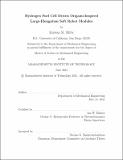Hydrogen Fuel Cell Driven Origami-Inspired Large-Elongation Soft Robot Modules
Author(s)
Hilby, Kristan M.
DownloadThesis PDF (132.0Mb)
Advisor
Hunter, Ian W.
Terms of use
Metadata
Show full item recordAbstract
Soft robots have gained popularity in recent years, especially in fields spanning medicine, space, to assistive robotics. Unlike traditionally rigid robots, soft robots offer inherent safety and a robust design. Furthermore, modular reconfigurable soft robots, which are robots composed of repeating reconfigurable units, provide the same benefits as traditional soft robots while also being able to perform a wide range of tasks based on their configuration. Such characteristics make them especially applicable for operations near humans. Though soft robots and reconfigurable soft robots have come a long way, they still cannot achieve motion over large ranges in a well-modeled, well-understood manner. Long-range movement is imperative for space applications and any task where the ability to stow in small spaces is crucial to their operation and transportation. Furthermore, to maximize their usage, qualitative and quantitative analyses are also required.
This thesis presents the design of a Yoshimura origami-inspired reconfigurable soft robot capable of achieving elongations up to 1715\%, over twice that of prior art in the field, using an adaptation of the layer-stacking method. By reconfiguring the modules between serial and parallel attachments, the robot collective can achieve linear motion, rotary motion, and locomotion. Furthermore, the soft Yoshimura module is easily integrated into traditionally rigid systems to achieve a truly versatile range of tasks. Computational finite element analyses provide structural and buckling behaviors. Experimental data, such as hysteresis, fatigue, and tensile testing profiles, validate computational results and offer further insight into performance and operational lifetime. These analysis techniques determined that no perceptible damage occurred during the unfolding of the Yoshimura structure, thereby suggesting they are suitable for long-term use.
Date issued
2021-06Department
Massachusetts Institute of Technology. Department of Mechanical EngineeringPublisher
Massachusetts Institute of Technology